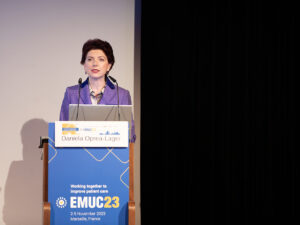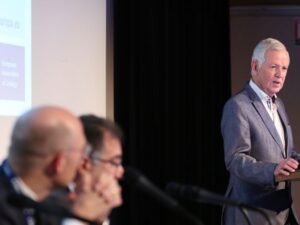Day two of EMUC23 introduced and implemented the morbidity and mortality (M&M) meeting format during the aptly-titled Plenary Session 4 ‘Learning points from morbidity and mortality’. This session concentrated on the learning to be gained from past cases, and was co-chaired by urologist Prof. Axel Bex (GB), medical lawyer Mr. Bertie Leigh (GB), medical oncologist Dr. Ursula Vogl (CH) and radiation oncologist Prof. Thomas Zilli (CH).
Mr. Leigh: “We will consider three cases in this session, using the format of an M&M Meeting. We will try to be candid and fair, looking for ways to improve practice. We asked our presenters to choose cases from which lessons may be learned. None of the cases have obvious negligence, but all present learning opportunities.”
A quality audit – measuring outcomes and complications
Asst. Prof. Giorgio Gandaglia (IT) presented a prostate cancer case from his institution for review.
- A 72-year-old male
- BMI 23
- Type 2 DM
- Medication: metformin
- PSA 4.3 ng/ml
- CT scan: prostate x 1.5, suspicious module right side, prostate 40ml; adenoma 20 ml, prostate biopsy showed adenocarcinoma of the prostate, FF2, 5/15 positive cores, bone scan was negative, abdominal TC: bilateral renal cysts
The patient underwent a robot-assisted radical prostatectomy. He was discharged on day three postoperative, but on day six, he was admitted to the ER with haematuria and fever, a malfunctioning of the bladder catheter. He was re-admitted to the ER on day 30 with the same complication.
Is it important to chase complications after robotic surgery? According to Asst. Prof. Gandaglia, a wide heterogeneity exists in the rate of postoperative complications after robotic surgery. Although, there has been an exponential increase in the papers using the Clavien-Dondo system over the last few years, only 65% of urologic manuscripts adopt the score correctly.
Asst. Prof. Gandaglia shared details on how his institution learnt from this experience. “The first phase of our prospective study consisted of an audit and feedback process, where the most frequent complications observed in our series were prospectively collected, and in January 2018 an appraisal was done. The most common complication was anastomotic leaks (6.7%). Changes in the surgical technique were proposed to improve outcomes after collegial discussion and review of the surgical videos were recorded during the audit and feedback phase.”
According to Asst. Prof. Gandaglia, the outcome was the introduction of a novel technique for vesico-urethral anastomosis. “The awareness of postoperative outcomes led to the implementation of changes in the surgical techniques that significantly reduced the risk of specific postoperative complications.”
Risks of radical cystectomy
Dr. Carmen Mir (ES) presented a bladder cancer case and how the outcome led to learning and making changes to limit the chance of surgical site infections. She stated that reviewing the risks of radical cystectomy need to cover interoperative, in-hospital, early recovery, and long term. Changes implemented in her institution from this case included fragility assessment for patients over 70 years old, redoes antibiotic therapy and the use of chlorhexidine for prepping. “We also change the surgical instrument set at closure, use running 5mm 1-0 resorbable elastic monofilament, and saline for wound clean up before skin closure”.
A take-home message from Dr. Mir was “Look at your own institution and see what is working and what’s not working. There are a lot of small things that could make a difference to the outcome”.
A need for anticoagulation therapy (ACT) pre-operatively?
Prof. Faiz Mumtas (GB) presented a complicated kidney cancer case of an 80-year-old male with a high BMI of 38 and a visible haematuria with a normal MSU, blood profile and cystoscopy. He had a permanent pacemaker for asymptomatic bradycardia.
According to Prof. Mumtas, in the patients initial CT scan he had a level 2 Pt3b caval tumour. “His staging CT and MRV (Magnetic Resonance Venography) got delayed whilst waiting for a cystoscopy and so he represented with a saddle pulmonary embolism (PE) with an extension in the caval tumour height. With extensive PE we did anticoagulated therapeutically with no significant haemodynamic improvement. Surgery was delayed due to recurrent PE. This further delay led to the growth of the tumour size and it now approached the level of the hepatic veins making it level 3. This indicated a significant progression.”
Prof. Mumtas stated that a cardiac bypass had to be performed at a different institution. He concluded his presentations with the learning points from this case:
- Anticoagulation in the presence of high-risk factors – recurrent VTE (venous thromboembolism) and bland tumours
- Concerning up-to-date imaging, Prof. Mumtas suggests no more than a couple of days before surgery.
- Further multicentre studies are needed to explore the role of pre-operative anticoagulation and neoadjuvant systemic treatments.
- Operating on level 3 tumours only in facilities where cardiac bypass is available, is to manage patients who become haemodynamically unstable with supra-hepatic clamp.
You can watch a webcast recording of the full presentations on the EMUC23 Resource Centre.





